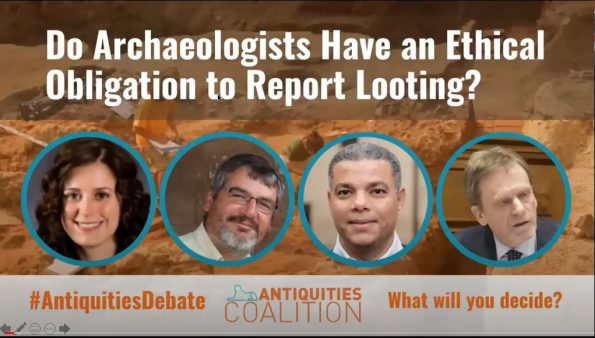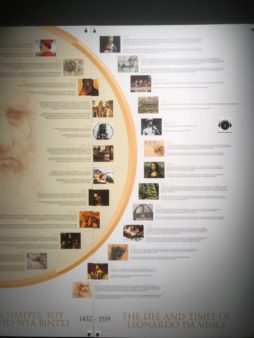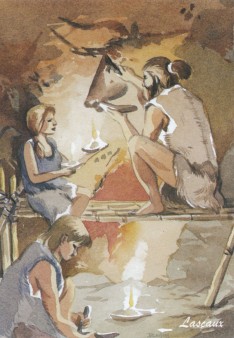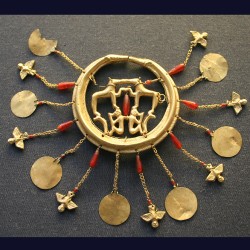
How does a girl-power manual would look in 1504? It only takes to browse “Lives of Famous Women” to find out.
In the very beginning of the 16th century, French Queen Anne of Brittany ordered educated Dominican monk Antoine Dufour to compose for her a series of biographies narrating the lives of important women.
Her order was materialized in the form of “Les vies des femmes célèbres“, an illuminated manuscript where the lives of 91 historical and mythical women, from Eve to Joan of Arc, are described and depicted in a book suitable for a true female leader.
It is not difficult to think of Anne seeking inspiration from great women of the past. In an era when the idea of Homo Universalis represented the ideal man, women followed suit. Many royals and aristocrats actively developed a taste for intellect, knowledge as well as beauty. They became patrons and inspiration of various artists, scholars, and explorers. Anne was contemporary to Spanish uber -Queen Isabella of Castille, Italian aristocrats Catherine Sforza , Isabella d’Este and Lucrezia Borgia and two generations behind Elizabeth I of England herself. Indeed, Anne was a strong competitor. She left back a legacy of ideal queenship, as one of France’s successful female rulers.
For the record, the manuscript still survives in the Dobree Museum, Nantes, France.

To report or not to report? A shocking majority of archaeologists had an experience connected to the looting of archaeological sites during their fieldwork career. Yet, while the vast majority of them proceed with taking action, the rest provide ethical and authority issues to justify their reluctance to doing “the right thing”. But how possible is actually doing so?
The above formed the subject of an impressive Live Debate by The Antiquities Coalition. The debate took place on April 29, 2020, and is now available on YouTube. The discussion’s moderator was Deborah Lehr (Antiquities Coalition Founder and Chair of the Board of Directors); the panel consisting of Prof. Blythe Balestrieri (archaeologist-criminologist), Prof. Luis Jaime Castillo (archaeologist, ex-Minister of Culture in Peru), Prof. Ramadan Badry Hussein (ex-Chief of Staff to the Ministry of Antiquities in Egypt, now Director of the Saqqara Saite Tombs Project) and Justice Luigi Marini (Italian High Court, an adviser to the Permanent Mission of Italy to the U.N. specializing in cultural heritage preservation).
The discussion was prompted by a research project by Prof. Balestrieri whose results were published in The Antiquity Coalition’s Policy Brief No. 6 (March 2020) under the title “Do Archaeologists Have an Ethical Obligation to Report Looting? Protecting Antiquities and an Ethical Double Standard”.
Research Data
Balestrieri’s research had been based on the results of an online survey and follow-up interviews. Since 2007, 2,400 archaeologists from around the world responded to the survey and follow up interviews reached the number of 662. Responses showed that 80% or archaeologists asked had a personal experience with looting (evidence on the site, approached or interacted with a looter, etc) on more than one occasion. But in the question regarding their’ reaction to the experience, the archaeologists’ answers varied from taking some action to not doing anything at all. The latter consist a whopping 24% of the participants.
According to Prof. Balestrieri’s research, many of the archaeologists who chose to remain inactive justified their position as sympathizing with the looters’ attempt to fight extreme poverty and hardship. Others stated the fear to alienate the local community and having trouble with working in the future, while, in other cases, remote looting events are part of the action of large criminal networks, and archaeologists choose not to intervene out of fear for their lives. The panel also raised the subject of distrust to the authorities; Prof. Hussein, discussed in length as he had faced it in his days as Chief of Staff to the Ministry of Antiquities.
The Debate
Can then such reasons be compelling enough to justify an archaeologists’ reluctance on taking action against looting happening in front of their eyes. And this, especially when archaeologists see themselves as stewards of cultural heritage?
When one could easily respond with a straight “No”, things might not be black and white but rather grey, as several of the online discussion’s expert panelists stated. In Lehr’s question on whether an archaeologist should be held criminally responsible if they do not report illegal archaeological activity, the panel answers “it depends”. Factors taken in the account include: particular details in the case witnessed, the state of the country the event is taking place, the social condition of the looters, etc.
The panel chose to prefer the grouping of archaeologists between local civil servants (to whom reporting is a legal obligation) and members of foreign missions (with no legal duty before the country hosting them) as key in justifying potential responses to the phenomenon. Finally, the panel discusses policies that would help to educate archaeologists on the looting matters faced in their country of research and local communities understand that they could profit more from protecting and promoting their antiquities rather than by contributing to their looting.
For the whole discussion and recommendations from the audience click here.

Leonardo Da Vinci: what the fuss is all about? This is the question which the spectacular exhibition “Leonardo Da Vinci: 500 years of genius“ aims to answer. But, does it do it? And is a possible answer to the above, enough to conceive what the ultimate Renaissance man was “made of” and why his life and times are that relevant today? I visited the exhibition as displayed in Athens, Greece, and here is what I got…
Three exhibitions on Leonardo in one
The show consists of three exhibitions in one. Indeed, I could distinguish between the first part dedicated to Leonardo’s inventions and art, another which focuses on a theory about the making of the Mona Lisa and a third one which aims to create a Da Vinci “experience” to the viewer, in a similar way it happened with “Van Gogh Alive” exhibition last year. I would better divide between a “tangible” and a “visual” section; the first consisting of replicas of the things he made or imagined, and the second, based on photos and video-projections.
Leonardo’ s Tangible Universe
Entering the hall, a timeline of Leonardo successfully places his activities into the history of his era. Then follow the replicas of the manuscripts where Da Vinci’s thought is recorded, surviving mostly as notebooks set into codices. Timeline and replicas are the only indicators of Leonardo’s historical context, at least for the tangible part of the exhibition. And then, true fun begins! Lifesize models of the machines he designed (flight, underwater action, war machines, theatrical productions, etc) fill the space. Functional models of systems he invented in order to place within machines are there for the audience to fiddle with. A famous Da Vinci optics experiment inspired my personal favorite; a fascinating installation of mirrors aligned along the interior walls of a polygonal cabin. Here you can enter and marvel at your endless reflections!
Posters of Leonardo’s surviving paintings, anatomical studies, and important sketches were also there enabling any visitor to familiarize with the Master’s major artworks. Still, this was not the exhibition’s best part. Latest paintings identified as Leonardo’s work (such as Salvator Mundi) are absent. The use of photos instead of true reproductions of the paintings (the lack of texture meant much of the technical data was not there), the absence of chronological information from the labels and the limited reference to the historical background of the paintings meant that the display pointed to answering “what” did Leonardo make, leaving aside the “why and how”, at least for the paintings. I make an exception for the presentation of Leonardo’s iconic Vitruvian Man; here, an interactive panel presents the characteristics, background, and meaning of the masterpiece. And the viewers can discover them all at their own pace.
Leonardo’ s World as Immersive Experience
It was then when I walked through the exhibition’s second section, which consists of two major projections.
The smaller one highlights on Leonardo Da Vinci’s masterpiece The Last Supper, and it follows the typical format of an explanatory video.
The larger one is an impressive spectacle developing in a number of mega-screens (along walls, the ceiling, and the floor) where the visitor “immerses” to Da Vinci’s world through a sequence of images relevant to the Italian Renaissance, the places he got active, his patrons and his work. Music accompanies all in a captivating manner while quotes of the Master himself and images complete one another. The whole gives a glimpse of Leonardo’ worldview in connection with his environment and work. And it includes the sets of info missing from the tangible exhibits
Impressive or plainly camp? It is impossible to say. True, however, it explains a lot on the background of what we have already seen. And one has to admit: it IS fun!
Mona Lisa’ s Secret Revealed
The third section is a photo exhibition presenting a controversial as well as interesting theory about the making of the Mona Lisa. Here, the visitor can see the iconic painting as developed; we discover how technology revealed that Lisa Gherardini and the Mona Lisa are, in fact, different from each other! Again, the focus here is on technical advances that allowed us to reach the surprising result; the whole may not be fully understood by every person in the room. And again, the analysis involves only the human figure on the painting and not the surrounding landscape, on which there is also a long bibliography attempting to solve the making of the masterpiece. Still, the very idea that the world’s most recognizable female face is, in reality, a kind of palimpsest and it does not represent a specific person, is enough to impress everyone, with or without a tech background.
The Verdict
The display is, overall, impressive! Observing the spectacular constructions, which certainly reflect Leonardo’s advanced sense of the world, one cannot help but marvel at the extent to which the ultimate Renaissance Man was able to observe and then decode the nature’s forces. Without a doubt, the exhibition shows Leonardo as an individual not only eager to understand the world but willing to make it a better place to live through practical solutions to both tangible and theoretical problems.
Even with its limited “faux- pas”, it remains faithful to its title which focuses on the man’s “genius”, purely devoted to practical knowledge at its best. True: Leonardo might have been many things but he was not -and never aspired to become- a “theory scholar”. His self-taught, creative mind could produce “how-to’ s” set in a non-defined time or space. The lack of historical background info in the exhibition might put a “Mona Lisa smile” on the face of the history geeks among us. Still, this exact type of display might actually reflect Leonardo’s take on the world: a bird’s eye view to an endless space for inspiration. And a visit was definitely worth it!

News about the rediscovery of a long-lost inscription in a long-lost language referring to a Trojan Prince circulates the internet since last week, and not without a reason.
Direct references to places known widely through both myth and archaeology (without these two essentially correlating), princes and wars, extinct languages and nations lost forever under the sands of time, all consist catchphrases for a community for whom archaeology as a discipline is always interlocked with the longing of bringing to life stories of glorious individuals and the series of unfortunate events that dramatically led to their demise.
Publicity, as a magnifying lens, gradually transformed the content of the news; in a couple of days the “3,200 – Year- old Stone Inscription tells of Trojan Prince, Sea People” was seen as “Luwian Hieroglyphic Inscription Explains the End of the Bronze Age”. Still, what is important in this piece of news is not related to Mediterranean History but the history of archaeological material management as well as heritage journalism.
The first to seek for is whether the inscription actually enlightens us on the end of the Bronze Age. The text actually tells the story of how two subsequent kings of a city-state called Mira had secured their control over the nearby city of Wilusa (Ilion aka Troy) by overthrowing and then reinstating its king in exchange for his loyalty. The text, dating in around 1190 BC. is important in mentioning two persons related to Troy; king Walmus and a Trojan prince called Muksus who led a victorious campaign against the coastal city of Ashkelon (in modern day Israel) and set a fortress there. The reference to Ashkelon is the only bit that connects the inscription with the Sea Peoples phenomenon.
Overall, the information given could be seen as a story which is important within the context of the period’s history but not as a key incident that “explains the end of the Bronze Age”.
Secondly, it is interesting to notice is how this piece of info came to us and who transmits it. In a closer look at one of the first (thus less bound to impress) news reports we see that:
a. The original inscription does not survive as the slabs, it was engraved on had been allegedly used for the building of a mosque short after the first copy had been completed.
b. The text reached the current researchers through a copy of a copy of the original; the first copy was allegedly made in 1878 and was recopied in some undefined date in the third quarter of the 20th century by a team of researchers who never published it. The inscription finally seems to somehow be included in the archive of Near Eastern archaeology expert James Mellaart.
c. The mid 20th c. experts names are nowhere to be found, while it is mentioned they died before 1985. James Mellaart also died in 2012. What makes things trickier is that Mellaart had been accused as one of Archaeology’s greatest fraudsters; he had been accused of faking finds at Çatalhöyük, while he was banned from exercising archaeology in Turkey due to a case involving the location of a treasure known as the Dorak affair (1965).
The result is that there is no evidence that the inscription which modern experts boast to have rediscovered is genuine as there is no reference to it that predates Mellaart. In what extent, then, we had to marvel at something that may have never existed? Possible for the dimension the story gives to the “publish or perish” saying. This is because, in our case, it was not only the team of experts that perished as they did not publish according to time but the credibility of their find as well.

This image comes from a postcard released in France in relevance to the local (there) Lascaux cave archaeological site. From a first glance, there is just a beautiful and somehow naive picture of an imaginary past. But is it just that?
Not exactly. What caught my eye is that, contrary to the crude, “ape-like” posture adopted in mainstream depictions of prehistoric people, in this postcard, the people are “humanized”. The postcard’s artist has imagined the main cave painting creator as a tall slim man who retains his beard and long hair. After all, why couldn’t he be just like that? He is a Homo sapiens, just like us, not a Neanderthal or any other hominid. Secondly, the figures who help him are a young woman and a child, both equally slender and tame-looking. This is also a departure from what we normally see in “popular archaeology” representations of cave people, where gender roles are set in accordance to much later examples of ancient societies. Still, there is little evidence that cave artists were exclusively men and, more than that, that their helpers were also adult men. In that sense, this postcard’s artist has offered us an updated version of the way we see our distant forefathers.
